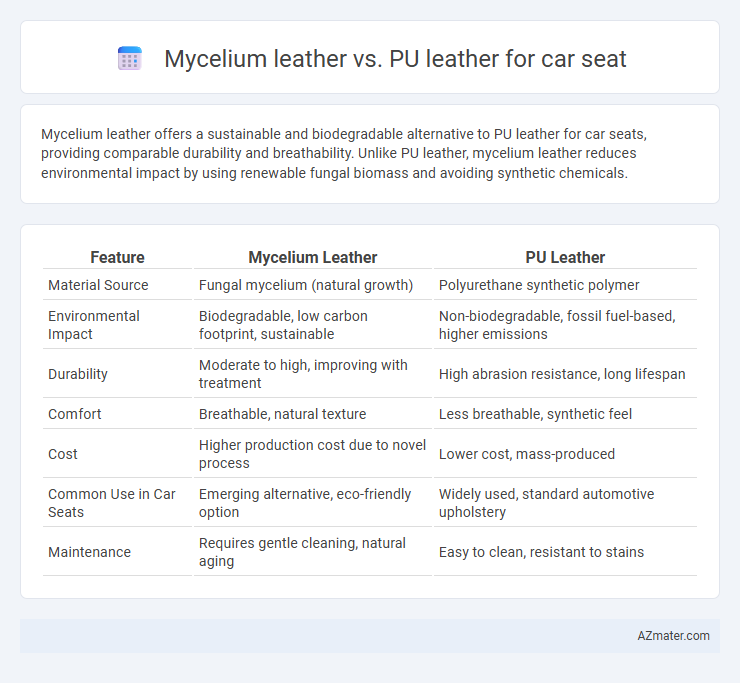Mycelium leather offers a sustainable and biodegradable alternative to PU leather for car seats, providing comparable durability and breathability. Unlike PU leather, mycelium leather reduces environmental impact by using renewable fungal biomass and avoiding synthetic chemicals.
Table of Comparison
| Feature | Mycelium Leather | PU Leather |
|---|---|---|
| Material Source | Fungal mycelium (natural growth) | Polyurethane synthetic polymer |
| Environmental Impact | Biodegradable, low carbon footprint, sustainable | Non-biodegradable, fossil fuel-based, higher emissions |
| Durability | Moderate to high, improving with treatment | High abrasion resistance, long lifespan |
| Comfort | Breathable, natural texture | Less breathable, synthetic feel |
| Cost | Higher production cost due to novel process | Lower cost, mass-produced |
| Common Use in Car Seats | Emerging alternative, eco-friendly option | Widely used, standard automotive upholstery |
| Maintenance | Requires gentle cleaning, natural aging | Easy to clean, resistant to stains |
Introduction to Mycelium and PU Leather
Mycelium leather, derived from the root structure of fungi, offers a sustainable and biodegradable alternative to traditional synthetic materials used in car seats. PU leather, or polyurethane leather, is a synthetic material made by coating a fabric base with a polymer layer, widely used for its durability and cost-effectiveness. Both materials aim to replicate genuine leather's look and feel, but mycelium leather emphasizes eco-friendly production and biodegradability, while PU leather prioritizes affordability and resistance to wear and tear.
Environmental Impact: Mycelium vs PU Leather
Mycelium leather offers a significantly lower environmental impact compared to PU leather, as it is biodegradable, requires less water, and generates fewer greenhouse gas emissions during production. PU leather relies on synthetic polymers derived from non-renewable fossil fuels, contributing to pollution and microplastic waste. Choosing mycelium leather for car seats promotes sustainable manufacturing and reduces the automotive industry's carbon footprint.
Durability and Performance for Car Seats
Mycelium leather offers superior durability for car seats due to its natural fiber network, providing enhanced breathability and resistance to wear compared to PU leather. PU leather, made from synthetic polymers, tends to crack and deteriorate under prolonged exposure to heat and friction, reducing its lifespan in automotive applications. Mycelium's eco-friendly properties combine with robust performance, making it a viable, long-lasting alternative to traditional PU leather in vehicle interiors.
Production Processes Compared
Mycelium leather, derived from fungal root structures, undergoes a bio-fabrication process that involves cultivating mycelium on organic substrates, resulting in a sustainable and biodegradable material with a lower carbon footprint compared to PU leather. PU leather, or polyurethane leather, is produced through a synthetic process that applies a plastic coating on a fabric base, involving petrochemicals and higher energy consumption, contributing to environmental concerns. The production of mycelium leather emphasizes renewable resources and minimal chemical use, offering an eco-friendly alternative for car seat upholstery compared to the chemically intensive and less sustainable PU leather manufacturing.
Aesthetic and Texture Differences
Mycelium leather offers a unique, natural texture with subtle organic patterns that enhance the car seat's aesthetic appeal, providing a more eco-friendly and visually distinctive alternative to traditional PU leather. PU leather, known for its smooth and uniform surface, delivers a consistent texture that can mimic genuine leather but often lacks the depth and irregularity found in mycelium material. The tactile experience of mycelium leather is softer and more breathable, contributing to a luxurious feel, whereas PU leather tends to be slightly stiffer and less permeable, impacting comfort and longevity in automotive interiors.
Comfort and Breathability
Mycelium leather offers superior breathability compared to PU leather, allowing for better air circulation and moisture management in car seats. Its natural fiber structure enhances comfort by reducing heat retention and sweat accumulation during extended drives. PU leather, while durable and easy to clean, tends to trap heat and lacks the same porous quality, making it less comfortable in varying temperatures.
Cost Comparison: Mycelium vs PU Leather
Mycelium leather for car seats typically costs 20-30% more than PU leather due to its sustainable production process and limited manufacturing scale. PU leather, being mass-produced with synthetic materials like polyurethane and polyester, offers a lower price point and widespread availability. Despite the higher upfront cost, mycelium leather provides added environmental benefits and durability that can reduce long-term maintenance expenses.
Maintenance and Care Requirements
Mycelium leather requires minimal maintenance, needing only occasional gentle wiping with a damp cloth to keep its natural texture and breathability intact, while PU leather demands more frequent cleaning and conditioning to prevent cracking and peeling due to its synthetic coating. Mycelium's biodegradable properties reduce the environmental impact of cleaning products, whereas PU leather often requires chemical-based cleaners that may degrade its surface over time. Both materials benefit from avoiding prolonged exposure to direct sunlight and extreme temperatures to maintain durability and appearance in car seats.
Market Availability and Trends
Mycelium leather, derived from mushroom roots, is gaining traction as an eco-friendly alternative to traditional synthetic options in the automotive seat market. PU leather remains dominant due to its cost-effectiveness and widespread availability, but rising consumer demand for sustainable materials accelerates the adoption of mycelium leather in luxury and electric vehicle segments. Market trends indicate a growing preference for bio-based, biodegradable upholstery materials, positioning mycelium leather as a key player in the evolving car seat leather market.
Future Prospects in Automotive Upholstery
Mycelium leather offers sustainable and biodegradable advantages over PU leather, providing an eco-friendly alternative for future automotive upholstery. Innovations in mycelium cultivation enable customizable textures and durability, potentially surpassing PU leather's synthetic properties in performance and environmental impact. As regulations and consumer demand shift towards green materials, mycelium leather is positioned to become a key player in next-generation car seat manufacturing.

Infographic: Mycelium leather vs PU leather for Car seat
 azmater.com
azmater.com